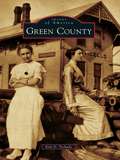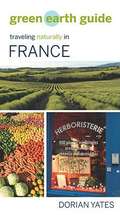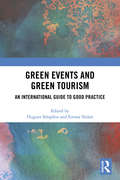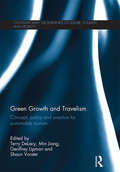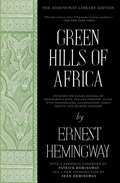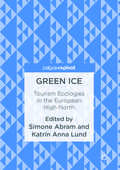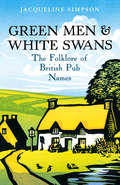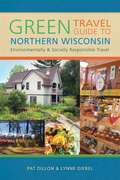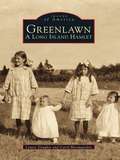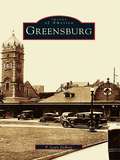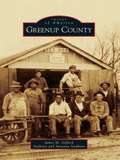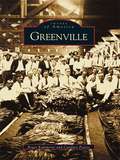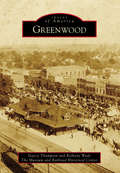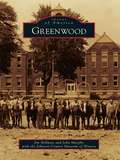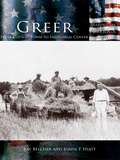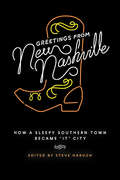- Table View
- List View
Green County
by Kim TschudyThis book presents a glimpse into Green County's colorful and historic past. Not only are the communities of present-day Green County included, but also within are the ghost towns Attica, Dayton, Dutch Hollow, Martintown, Postville, and Schultz. While far from a complete photographic history of Green County, the reader will get a glimpse of many of the lesser-known facets of its history, both physical and personal. It is the author's hope that this book will serve as a beginning point for the reader to venture deeper into Green County's collective past.
Green Earth Guide: Traveling Naturally in France
by Dorian Yatesgreen earth guide: traveling naturally in France is written for the twenty-first-century traveler with a conscience. The first in a series of ecologically minded travel books exploring Western Europe, Green Earth Guide approaches France with a focus on staying green, directing readers to the latest resources for local and organic foods, natural health care, ecological businesses, parks, organic vineyards, public transportation, and other places of interest. Written in a friendly, accessible style by th...
Green Earth Guide: Traveling Naturally in Spain
by Dorian YatesSurveys by the International Ecotourism Society reveal that more than three-quarters of American travelers feel it is important not to damage the environment they are visiting. Green Earth Guide: Traveling Naturally in Spain helps travelers to Spain accomplish that goal. Author Dorian Yates focuses exclusively on where to find things green and alternative in one of the world's most popular travel destinations: local and organic foods, natural health care, ecological businesses, organic vineyards, renewable energy, yoga and meditation centers, national parks, public transportation, and other green places and services of interest.Written in a friendly, accessible style with personal anecdotes, how-to travel tips, and practical information, this second book in the series is aimed at helping travelers leave a smaller footprint wherever they venture. The book rescues readers who are accustomed to a certain level of green consciousness at home but end up compromising their values on vacation. Author Yates shows how to make the most environmentally beneficial choices for basic needs--food, shelter, health, exercise--while enjoying sites of ecological, historical, and natural interest along the way.From the Trade Paperback edition.
Green Events and Green Tourism: An International Guide to Good Practice
by Emma Nolan Hugues SeraphinAs the appetite for leisure travel and events continues to grow at an exponential rate, the impact on the environment and local communities is becoming an increasing concern, not least by the users of the services. Green approaches to tourism and events are growing in popularity and present an opportunity to both identify solutions to significant environmental and societal problems and new approaches to business. <P><P>Green Events and Green Tourism looks at key frameworks, guidelines, principles and benchmarks that support the application of sustainability in practice. The five sections of the book cover themes of governance, accreditation, certification, innovation, priorities, trends, ambitions and consumer behaviour, and the chapters include examples of best practice in the organisation of music and arts festivals, special interest tourism, the green management of outdoor sites and the management of sports events. Readers will benefit from insightful case studies from around the globe.
Green Growth and Travelism: Concept, Policy and Practice for Sustainable Tourism (Contemporary Geographies of Leisure, Tourism and Mobility)
by Min Jiang Terry DeLacy Geoffrey Lipman Shaun VorsterThe green growth paradigm emerged from evolving global strategies that coherently promote a more socially inclusive, low-carbon, resource-efficient, stable economy, with decreasing poverty. Opportunities and challenges associated with the paradigm shift are expected to transform the travel and tourism (travelism) sector in all respects and on a global scale. This involves the transformation of the entire travelism value chain, as well as the communities in tourism destinations. However, there is a lack of systematic reports on wide-ranging and complex implications of the green growth paradigm for the travelism sector. This book focuses on the twin pillars – green growth and travelism – as key building blocks in exploring an essential multi-decade lifestyle change for planetary and human well-being, through the lenses of concept, policy and practice. It provides a conceptual discussion of the implications of the new development trend for key players in the travelism system, offers case studies from both developed and developing countries that highlight key issues in the transformation towards the green economy, and explores the policy settings and frameworks on both the global and national levels that underpin travelism green growth. This book offers tourism industry players, academics, students, policy makers and practitioners a comprehensive discussion of the latest progress in green growth and travelism.
Green Hills of Africa
by Ernest Hemingway"There are some things which cannot be learned quickly, and time, which is all we have, must be paid heavily for their acquiring. They are the very simplest things, and because it takes a man's life to know them the little new that each man gets from life is very costly and the only heritage he has to leave." -- ERNEST HEMINGWAY In the winter of 1933, Ernest Hemingway and his wife Pauline set out on a two-month safari in the big-game country of East Africa, camping out on the great Serengeti Plain at the foot of magnificent Mount Kilimanjaro. "I had quite a trip," the author told his friend Philip Percival, with characteristic understatement. Green Hills of Africa is Hemingway's account of that expedition, of what it taught him about Africa and himself. Richly evocative of the region's natural beauty, tremendously alive to its character, culture, and customs, and pregnant with a hard-won wisdom gained from the extraordinary situations it describes, it is widely held to be one of the twentieth century's classic travelogues.
Green Hills of Africa
by Ernest HemingwayThere are some things which cannot be learned quickly, and time, which is all we have, must be paid heavily for their acquiring. They are the very simplest things, and because it takes a man's life to know them the little new that each man gets from life is very costly and the only heritage he has to leave. In the winter of 1933, Ernest Hemingway and his wife Pauline set out on a two-month safari in the big-game country of East Africa, camping out on the great Serengeti Plain at the foot of magnificent Mount Kilimanjaro. "I had quite a trip," the author told his friend Philip Percival, with characteristic understatement. Green Hills of Africa is Hemingway's account of that expedition, of what it taught him about Africa and himself. Richly evocative of the region's natural beauty, tremendously alive to its character, culture, and customs, and pregnant with a hard-won wisdom gained from the extraordinary situations it describes, it is widely held to be one of the twentieth century's classic travelogues.rience that is the hallmark of the greatest travel writing.
Green Hills of Africa: The Hemingway Library Edition (Hemingway Library Edition)
by Ernest HemingwayHis second major venture into nonfiction (after Death in the Afternoon, 1932), Green Hills of Africa is Ernest Hemingway's lyrical journal of a month on safari in the great game country of East Africa, where he and his wife Pauline journeyed in December of 1933. Hemingway's well-known interest in -- and fascination with -- big-game hunting is magnificently captured in this evocative account of his trip. In examining the poetic grace of the chase, and the ferocity of the kill, Hemingway also looks inward, seeking to explain the lure of the hunt and the primal undercurrent that comes alive on the plains of Africa. Yet Green Hills of Africa is also an impassioned portrait of the glory of the African landscape, and of the beauty of a wilderness that was, even then, being threatened by the incursions of man. Hemingway's rich description of the beauty and strangeness of the land and his passion for the sport of hunting combine to give Green Hills of Africa the freshness and immediacy of a deeply felt personal experience that is the hallmark of the greatest travel writing.
Green Households: Domestic Consumers, the Environment and Sustainability
by Klaas Jan Noorman Ton Schoot UiterkampHouseholds are one of the main sources of waste and of other environmental impacts. This is a study of domestic consumption. Drawing on empirical research largely from The Netherlands, it takes households as consumer units and examines the entire household metabolism. This includes the way domestic demand can influence where and how goods and services are produced, resource flows through households, and the differential impacts of different lifestyles. It shows both what would constitute sustainable domestic consumption and how far there is to go to achieve this.
Green Ice
by Simone Abram Katrín Anna LundThis book presents lively case studies of tourism developments in the European High North from diverse perspectives. It compares views of the changing political ecology of a fragile region shaped by climatic and cultural factors. In exploring the mutual relations between new developments in Arctic travel narratives and tourism practices. Green Ice: Tourism Ecologies in the European High North pays particular attention to the changing discourses that produce, and are in turn produced by, encounters between contemporary Arctic peoples and territories. Questions of gender and nationality are considered alongside a comparison of texts and practices in different languages, examining the politics of language and its significant role in tourism. This title pays attention to the changing symbolic value of Arctic discourses in environmental movements, in order to consider the close connections between global forms of environmentalist discourse and action and local cultural responses. An engaging and timely work, this book will be of great interest to scholars of Geography, Anthropology, and Arctic Tourism.
Green Men & White Swans: The Folklore of British Pub Names
by Jacqueline SimpsonWhy do British pubs have such curious names? What tales lie behind the Moonrakers, the Hooden Horse, the Derby Tup? And why does the Green Man come in different shapes and sizes?In Green Men & White Swans, leading folklorist Jacqueline Simpson explores the fascinating stories behind pub names, uncovering the myths and legends, euphemisms and wordplays, heroes and even ghosts that have inspired pub landlords over the centuries. Spanning beloved locals from the Three Witches to the Three Nuns, from the Ashen Faggot to the Twa Corbies, this book is both an intriguing insight into the history of the British pub and a captivating journey through the country's dramatic past.
Green Travel Guide to Northern Wisconsin
by Pat Dillon Lynne DiebelGreen Travel Guide to Northern Wisconsinshowcases the best green restaurants, lodgings, shops, and activities in Wisconsin's Northland. Learn about exploring the cliffs and caves of the Niagara Escarpment while biking the Door Peninsula. Carpool to the Midwest Renewable Energy Fair in Custer where you can stay at a nearby solar-powered inn. Take an all day eco-geo-history tour of the north woods near Hayward, explore the Chequamegon-Nicolet Forest, kayak the Mississippi River backwaters, and much more.
Greenlawn: A Long Island Hamlet (Images of America)
by Carol Bloomgarden Louise DougherFrom the archives of the Greenlawn-Centerport Historical Association comes this striking visual history of the north shore Long Island hamlet of Greenlawn. Originally known as Oldfields, the area was settled in the early 1800s by farmers. The extension of the Long Island Railroad through the farmlands in 1867-1868 provided the impetus for the development of a profitable pickle and cabbage industry, the growth of the community, and the arrival of vacationers, many of whom soon became year-round residents. Greenlawn includes stories of the Halloween eve conflagration, the Adirondack-style vacation retreat, the opera house, the farmhouse murders, the vaudevillians, and the Pickle King, among others. Today, houses cover the old farmlands; yet Greenlawnwith -one main street of small shops, a railroad crossing that halts traffic throughout the day, and many historical buildings-still retains its small-town charm.
Greensburg
by P. Louis DeroseBy 1771, a cluster of cabins flanked what would become the most traveled east-west road between the Allegheny Mountains and Pittsburgh. This settlement, originally called Newtown, emerged as the nucleus of a growing community later renamed for the late General Nathanael Greene. By 1799, Greensburg was already the first county seat and site of the first courts west of the mountains. With the coming of the Pennsylvania Railroad and bituminous coal mining, Greensburg by 1885 was growing, prospering, and bustling with commercial activity. Utilizing rare photographs, some unseen in sixty years, Greensburg concentrates on the city's evolution past 1900, into the years of boom and growth, and through the 1950s, hinting of future decline.
Greenup County
by James M. Gifford Anthony Stephens Suzanna StephensGreenup County, bordering the Ohio River in northeast Kentucky, is rich in history and culture. Settlers first arrived in the mid-1700s and carved farms from the hardwood forests. Lucy Virgin Downs, the first white child born west of the Alleghenies, lived in Greenup County, as did Jesse Boone, brother of Kentucky icon Daniel Boone. The 20th century brought industrialization and economic diversification to the historically agricultural area. Ashland Oil, a Fortune 500 company, maintained corporate headquarters in Greenup County. Two steel mills, a large rail yard, an excellent hospital, and a number of surface mines also provided employment to many people who continued to work their family farms, too. This economic progress was mirrored in every aspect of county life as education, health care, and recreation all improved dramatically. Today Greenup County's history is appreciated by both longtime residents and cultural tourists.
Greenville
by Candace Pearce Roger KammererLocated along the Tar River in the eastern half of North Carolina, Greenville exists today as a thriving center of commerce, education, medicine, the arts, and quality living. Since its earliest days in the 1770s, the city has expanded in size and population with the arrival of the railroad, the popularity of tobacco, and the rise in education. Age covers a city with a patina of experience that is apparent in many aspects of Greenville. Such beauty is evident in the preservation of photographs and stories that pay homage to the city of yesteryear. Greenville is a celebration of the community's coming of age. The images within these pages reach over the horizon of memory and evoke the proud chapters in the city's history. The pictures speak of simpler days, hard work, buggy rides, a stick of candy, and peoplewatching the trains come in. They recall the days when steamboats plied the Tar River and when the tobacco market was the most important time of year. Yet, this volume does not merely depict a vanished ghost; the subject lives on, surviving through renovated buildings, along streets that have simply evolved, and in the faces of the children and grandchildren who, as it turns out, are not so different from those captured in these scenes.
Greenville-Pickens Speedway
by Scott KeepferAs the second-oldest NASCAR track still running weekly races, Greenville-Pickens has earned a unique niche in racing history. In 1959, local driver David Pearson sped to a record 15 victories in one season, jump-starting a Hall of Fame career. As a young boy, Dale Earnhardt played in the infield while his father, Ralph, raced to the track championship in 1965. In 1971, ABC's Wide World of Sports televised the first live, start-to-finish NASCAR race at Greenville-Pickens. Many big names have competed here, but for every David Pearson and Richard Petty, there have been dozens of Donnie Bishops and Toby Porters: local favorites providing weekly thrills for a loyal fan base.
Greenwood
by The Museum and Railroad Historical Center Bethany Wade Stacey ThompsonNamed by an early settler's wife as she gazed at the lush surroundings of her summer home, Greenwood was incorporated on December 21, 1857. Growing from a fledgling village into a town that at one time boasted "the widest Main Street in the world," the city grew due to two industries: the railroad and textiles. Railroad companies such as Piedmont & Northern and Seaboard built their way through Greenwood, while textile tycoons such as James C. Self and John Pope Abney worked hard to increase productivity and job opportunities. Soon, education, businesses, and community services followed suit. Greenwood was booming, making the small town a place of educational advancement, great entrepreneurial spirit, and community-minded individuals.
Greenwood (Images of America)
by John Murphy Jim Hillman Johnson County Museum of HistoryBy 1813, in an area originally inhabited by Native Americans, including a significant Delaware Indian village located on White River's western banks, the future Greenwood was made safe for settlement by the Kentucky and Indiana militias. In 1818, with the New Purchase treaties and establishment of Whetzel Trace, the earliest east-west transportation route through central Indiana, the dense, overgrown forest became readied for settlement. Arising from humble beginnings as Smocktown, the community was officially named Greenfield in 1825, followed by renaming to Greenwood in 1833. The territory has seen tremendous growth through the decades since John B. and Isaac Smock arrived, transforming the land from a pioneer village into a contemporary hub of business and industry. Accused of being a "bedroom community" of Indianapolis, Greenwood strives to maintain its relevance as a unique and historically proud community.
Greer: From Cotton Town to Industrial Center
by Joada P. Hiatt Ray BelcherOriginating as Greer's Station, a burgeoning settlement on the edge of an antebellum plantation, Greer prospered as a link in the cotton belt of the South. Agricultural hub and industrial powerhouse, the town flourished along the railroad and gained prominence as a bustling trading post. Greer has braved market manipulation, commercial competition, and agricultural decimation, but strives even today to preserve the continuity of its community identity.
Greetings from Chicago
by Editors of Thunder Bay PressWhen it's time to go back to the daily grind, it's easy to miss the fun and excitement of vacation - especially if you've just spent time in a city like Chicago. Home to remarkable landmarks like Wrigley Field, vibrant neighborhoods like Wicker Park and Logan Square, and the Art Institute with its stunning works of art, it's the type of place that inspires anyone who visits.Greetings from Chicago features loads of fun facts about everything from songs with lyrics about Chicago to trivia about the people, the neighborhoods, and the culture of the Midwest town. It's the perfect keepsake for anyone nostalgic for days rolling along on the El - or anyone who's ever dreamed of doing it.
Greetings from Las Vegas
by Peter MoruzziThis book of vintage Vegas ephemera offers a guided tour of Sin City&’s rise out of the Mojave Desert to become a major entertainment destination.Greetings from Las Vegas tells the story of Las Vegas during its golden age in the first half of the twentieth-century. The city&’s miraculous evolution comes alive through a fun and diverse collection of vintage photos, picture postcards, matchbooks, ads, and other ephemera. This beautifully illustrated volume captures the glamor of Fremont Street and the Las Vegas Strip, landmarks such as the Sands and Riviera hotel casinos, and the cream of Hollywood glitterati, including Frank, Sammy, Dino, and the rest of the Rat Pack. Author Peter Moruzzi&’s sharp and irreverent commentary provides essential context for the visual treats as well as a unique historical take on the evolution of this desert playground.
Greetings from London
by Editors of Thunder Bay PressTrying to make the guards laugh at Buckingham Palace. Touring the Tower of London. Shopping in the flea markets of Camden and Notting Hill. These are but a few of the activities that would make up the perfect London vacation. It's a trip everyone should take-but until you can, there's Greetings from London!This unique book offers an introduction to what makes London so special: its history, its architecture, its people and its places. Full-color images tell a compelling story of the city's past and present, while quotes from famous writers explain why they love the city-and why you should too!London is calling! With Greetings from London, you'll experience the city as never before, in all its royal, renowned glory.
Greetings from New Nashville: How a Sleepy Southern Town Became "It" City
by Steve HaruchIn 1998, roughly 2 million visitors came to see what there was to see in Nashville. By 2018, that number had ballooned to 15.2 million. In that span of two decades, the boundaries of Nashville did not change. But something did. Or rather, many somethings changed, and kept changing, until many who lived in Nashville began to feel they no longer recognized their own city. And some began to feel it wasn't their own city at all anymore as they were pushed to its fringes by rising housing costs. Between 1998 and 2018, the population of Nashville grew by 150,000. On some level, Nashville has always packaged itself for consumption, but something clicked and suddenly everyone wanted a taste. But why Nashville? Why now? What made all this change possible? This book is an attempt to understand those transformations, or, if not to understand them, exactly, then to at least grapple with the question: What happened?
Greetings from Rome
by Editors of Thunder Bay PressWalk the streets of Rome, and you'll experience thousands of years of history come alive. But as you marvel at the beauty of the Sistine Chapel and the majesty of the Colosseum, you will also pass elegantly chic shops and restaurants serving the best spaghetti carbonara you've ever tasted. The present and the past mingle easily in Rome - and in this amazing book!Greetings from Rome details the history, architecture, people, and culture of this awe-inspiring city. With full-color images of sites such as the Spanish Steps, the Pantheon, and St. Peter's Basilica and quotes from famous writers that offer their own love for the city, this exciting book tells the complete story of Rome from its ancient beginnings to its fantastic present.Toss a coin in Trevi Fountain and make a wish! Once you've read Greetings from Rome, you'll want to return to the Eternal City again and again.
